

Prior Episodes | 7967 (10 BBY) | Next Episodes
Continuity & Analysis
Solo: A Star Wars Story (2018)
It is a lawless time. CRIME SYNDICATES compete for resources - food, medicine, and HYPERFUEL.
On the shipbuilding planet of CORELLIA, the foul LADY PROXIMA forces runaways into
a life of crime in exchange for shelter and protection. On these mean streets,
a young man fights for survival, but yearns to fly among the stars....


CONTINUITY
This film takes place 9 years after Episode III and 10 years before Episode IV, except for the prologue.
The prologue takes place in 7964 (13 BBY), which is 3 years before the rest of this film and 6 years after Episode III.
The planets Corellia, Mimban, Vandor, Savareen, and Numidian Prime are seen for the first time. Six worlds are seen in the film:
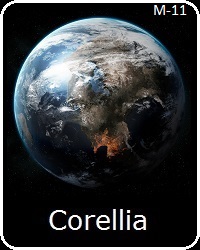
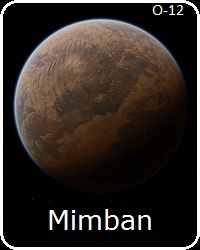
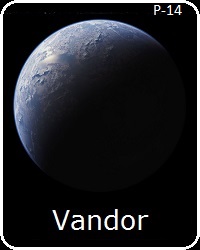
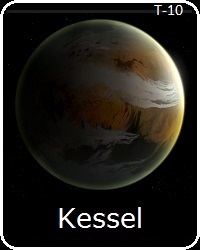
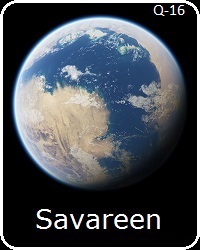

The prologue of the film takes place during one day, set 3 years earlier. The rest of the film takes place over the course of 6 days.
Day 1 - Battle of Mimban --> Leaving Mimban. Day 2 - Shower --> Camping at night. Day 3 - Train job --> Leaving to find Lando.
Day 4 - Sabacc game --> Journey to Kessel. Day 5 - Arrival on Kessel --> Qi'ra sails away. Day 6 - Han wins the Millennium Falcon.

Prologue events take place in 7964 (13 BBY) - 3 years prior to the main story.
- This is Han's earliest appearance chronologically. According to supplementary material, he is 22 years old in the prologue. Qi'ra is 21 years old.
- Corellia is a terrestrial planet located in the Corellia Sector, in the Inner Core region of the Core territories. The Corellian Run, a major galactic hyperspace
route, leads from Coruscant directly to Corellia, from which it runs all the way to the edge of the galaxy. The Corellian Trade Spine branches
off from that route just outside the Corellia System, making the system the intersection of two of the galaxy's most significant and oldest
hyperspace routes. These routes run to Corellia as a result of the planet's importance in early Human colonial history as a springboard for
exploration and colonization efforts, and its ancient role as a center of shipbuilding. Corellia is enormously significant to interstellar history,
and galactically famous in any era. The planet has a largely temperate climate and an abundance of water. The large oceans are separated by
several large landmasses, the majority of which forms the planet's primary continent. The planet has an extensive ecosystem with a wide
variety of native lifeforms. It was colonized by Humans from Coruscant or one of its colony worlds well before Humans discovered hyperspace
travel, however its early history has been lost. The world was already prominent when it joined the early Republic, and would go on to become
a galactic institution. In the 'modern' era of the films and shows, it boasts a large population and is heavily urbanized, although there are many
areas of Corellia which remained undeveloped. Its capital is the large city of Coronet, also called Coronet City, which is the center of Corellia's
famous shipbuilding activity. Coronet is the headquarters of the Corellian Engineering Corporation, hosts the Santhe Shipyards which is a major
affiliate of Kuat Drive Yards, and no doubt hosted numerous smaller entities connected to starship construction. The heavily industrialized
state of Corellia's built-up areas leads some to describe the world as "putrid sewer" or to suggest people don't often want to return to
the planet after they have left, however there are no doubt many areas of Corellia which are more inviting than others. Corellia has many
spaceports, including the Coronet Spaceport in its capital. "Corellian ships" were first seen and mentioned in Episode IV, however
Corellia was not seen in canon until this film despite decades of legends material about it.
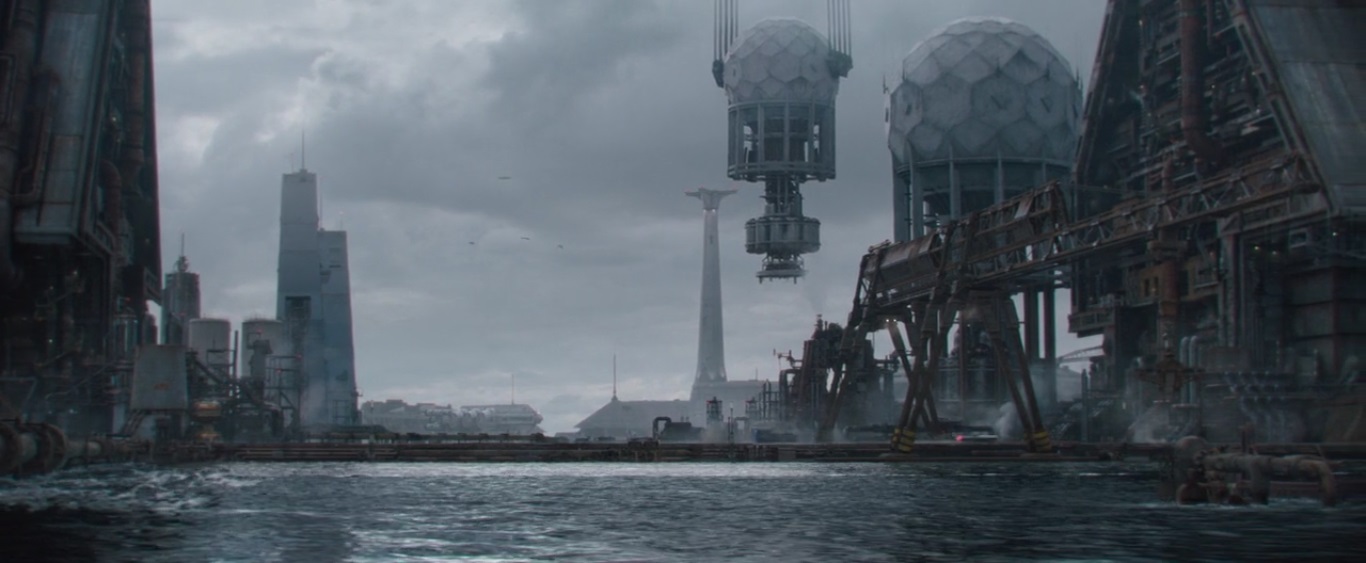
- The White Worms are a criminal gang dominated by Grindalids, which operated in Coronet during the reign of the Empire. Their leader is Lady Proxima,
described as "foul" for employing orphan Human children as thieves in exchange for food and shelter. Her top lieutenant is Moloch. They
have an unofficial standing with the Empire as a legitimate local interest, in keeping with standard Imperial policy towards organized crime.
- A single, relatively small vial of coaxium is worth about 500 or 600 credits. That is described as being possibly enough for two people to buy their way
out of the "control zone" in Coronet, which is an Imperial security regime in place in part of the city. It can be assumed that there are designated
districts for the wealthy and property owning portion of the city's population, where they can move freely, and that the control zone demarcates
a proletarian sector, where laborers are kept in semi-imprisonment. This prevents workers from leaving without sufficient wealth, keeping needed
labor for industry, and centralizing the most troublesome part of society in one area which can be heavily policed. Earning enough to escape
such slums is usually extremely difficult for those stuck within a control zone. Coaxium is an example of the many items which are considered
contraband for civilians to possess, and an individual could be detained just for possessing a single vial.
- Han has lucky "dice", which are two chance cubes which have been connected with a chain and plated with a golden metal. These are supposed to
be the same "dice" which can be seen in one scene from Episode IV, but only if one is looking for them, as they are not particularly
noticeable. They are presented here as sentimentally valuable to Han, contradicting the legends material which suggested that Han
acquired them along with the Falcon. They do not appear in any other canon material.
- The heavy Imperial security at the spaceport, and within the city itself, is indicative of the strength of the Empire's security regime 6 years after
it was declared. The Emperor's plans for an all-encompassing security state were introduced gradually, to build familiarity and reduce
resistance, however the identity documents which underpin the entire system were introduced early in the reign of the Empire. This
began with chaincodes and other biometric identifiers, and simple computerized identity papers like the 'identity chip'. The spaceport
public address indicates that travelers will need a boarding pass and ID chip to pass through security, and that all droids must be
registered. The boarding pass is probably not new in the Empire, however the other measures are probably recent additions.
- The Corellian Security Forces are the state police of the Corellia, which in the time of the Empire are fully integrated into the federal security
apparatus as a local arm of the Imperial Security Bureau. The emigration officer that Han and Qi'ra deal with is named Falthina Sharest.

A mother and father are seen being taken away from their children by Imperial troopers. What exactly was going on?
There could be any number of explanations, and obviously the film was implying that these kinds of things happen
all the time in the Empire. Several other individuals are taken away, some possibly fitting the description of Han,
however this particular detention might not be connected to that security alert, as there was much going on at this
spaceport. The real question in the case of the detained parents is whether this is a case of the Empire being not
concerned about separating kids from suspect parents, or if the children will be taken for some nefarious purpose.
As we are not privy to enough information to draw a conclusion, it is difficult to speculate on the troopers' motives.
- The Imperial military recruitment advertisement playing at the spaceport extols listeners to "Be a part of something. Join the Empire. Explore
new worlds. Learn valuable skills. Bring order and unity to the galaxy! Be a part of something. Join the Empire." This is very similar to
historical recruitment advertising in the US, Britain, and other militaristic 'democracies' which presents the military as a place for
lonely, purposeless, or alienated people to find meaning and belonging, an exciting opportunity for free travel, a place to learn useful
job skills and get a good reference, and a place for those who believe that the national ideology needs to be imposed on others by
force. The video also shows a Cantwell-class arrestor cruiser, Imperial-class destroyers, and TIE/ln starfighters. The Cantwell-class
was to be seen in the next scene which was deleted, but nonetheless became canon when seen in the advertisement. One was since
seen in action in Andor. The design of these ships is based on early concept art for the Imperial-class star destroyers. Their
presence in this advertisement suggests they were already in use in 7964 (13 BBY), which places their production sometime before
this year. Disney supplementary material says they were introduced in 7959 (18 BBY), which is unlikely but not impossible. It is
unlikely they existed in large numbers before 7962 (15 BBY), and most are likely only a few years old at this point. TIE/ln fighters
were already in service in 7962 (15 BBY), and have gradually supplanted the V-wings as the main Imperial fighter since.
- The recruitment office is behind a security gate requiring boarding passes, which is a strange place for accessibility reasons, and because most
people who will pass it have already spent money on a ticket to do something else with their lives. Despite these impediments, this office
is clearly busy and important enough to require two duty officers of significant rank. The recruitment officer who gives Han his surname
is Commander Drawd Munbrin, and his lower-ranked counterpart is an unidentified Fleet Captain, both officers of the Imperial Navy.
Why exactly this operation is run by ranking members of the Navy is not certain, however it is consistent with typical practice for large
militaries engaged in recruitment to have mid-level ranking officers whose advancement has stymied voluntarily or otherwise take a post
as a recruiter. This appears to be a general recruitment office for all branches of the military, so the Navy's involvement could be due to its
primacy, as the Navy is the central branch of any spacefaring military. It could also be that other officers who work here are from other
branches, or that this is a Navy office because it is in a spaceport. Munbrin is often incorrectly identified as a 'Captain' by supplementary
material, because of disney-Lucasfilm's Rogue One rank chart, which incorrectly reverses the order of these two ranks in SW.
Main Article: Ranks and Rank Insignia
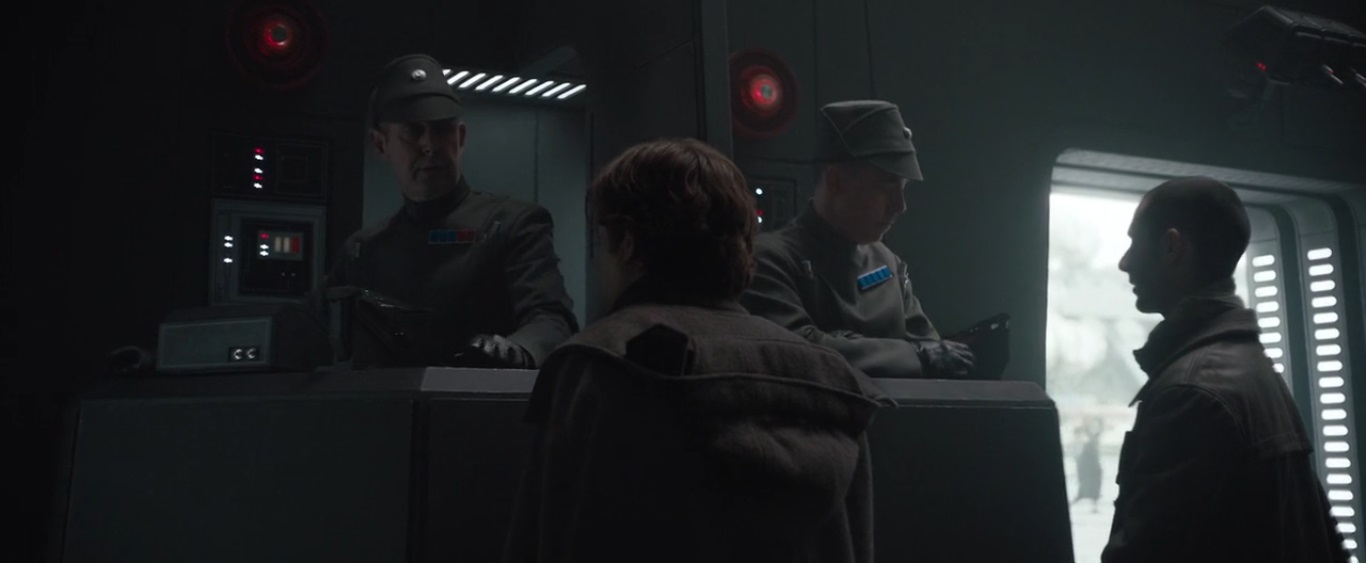
- The Empire has a huge military and its policies stipulate that it cannot really ever have too many troops. As a result, recruitment is a priority,
and they will take any able-bodied person willing to serve. It is not totally surprising, therefore, that their recruitment process is
unusually streamlined, as after giving his service branch preference and name, Han is given orders and dispatched to an academy
on the spot. No physical, no mental health evaluation, no background check was apparently needed. Perhaps their procedures
during intake at the academy would be more through. An applicant might be able to become a pilot if they apply for the Imperial
Navy, however most recruits are assigned to the infantry, which has the greatest manpower requirements. Han is sent to the Imperial
Flight Academy on Carida, which is a world known to host important military facilities even during the age of the Republic.

Events were supposed to jump forward some amount of time less than 3 years, before jumping again to Mimban and
the events of the main story set 3 years after the prologue, however two brief scenes depicting the events which got Han
kicked out of the Academy were deleted. Han was a Cadet at the Imperial Flight Academy on Carida, which is an officer in
training, in his case to become a fighter pilot. He crashes into a Cantwell-class arrestor cruiser while trying to save his
fighter, despite being ordered not to attempt a landing. His fighter was damaged during exercises because of actions Han
took to save a fellow Cadet's life. The Empire values only obedience, cares little for the brotherhood of arms, and always
'leaves a man behind.' As a result, Han is court-martialed before a 'tribunal' on Carida and found "guilty of disobeying
a direct order." He is stripped of his Cadet rank and reassigned to the infantry as a Trooper. Given that his unit is said to
already be on Mimban, it can be assumed that this is close in time to following events, and that most of the 3 years
had already passed. Most military schools have three or four year training programs. There are six officers at this
"tribunal", so the three behind Han must just be there to watch or something. Only the three officers he is facing are
seen to vote, however those behind him are not shown at that point. Strictly speaking, anything with more or less than
three judges isn't a tribunal. The proceedings are led by Rear Admiral Almudin, and the other two judges are another,
unidentified Rear Admiral also from the Navy and Major Ardwyl Hercho, from the Naval Infantry Corps. Almudin states
clearly that his rank is "Commodore", which is not what his rank insignia says it is. Either the dialogue is wrong or his
insignia is wrong, as it clearly indicates he is one rank below a Vice Admiral, which makes him a Rear Admiral. This is not
a continuity error only because the scene was deleted, and is therefore only semi-canonical. The insignia should have
been changed to match the dialogue. Ironically, Han mistaking his rank for a Moff is part of the dialogue in the scene.
Main Article: Ranks and Rank Insignia

Events jump forward 3 years from 7964 (13 BBY) to 7967 (10 BBY). Location jumps from Corellia to Mimban.
- The Battle of Mimban was a full-scale invasion by the Empire to overthrow an independent government which had come to power, in which
they fought against the forces of the Mimbanese Liberation Army. The Empire's official justification, as communicated by Lt. Bolandin,
was to "bring peace and prosperity to the galaxy, install a regime loyal to the Emperor, and eradicate the hostiles." Given the scale of
this war, it likely went on for months, or possibly years. This campaign was already taking place when Han was assigned to a unit on
Mimban, and it is assumed at least some time has passed since the deleted scene on Carida. The Empire's ground forces were meeting
stiff resistance in the ground battle, however the Empire's extensive air campaign kept the tide of battle in their favor. Mimban had
been the site of a Clone Wars battle, as well, where the Republic had occupied the planet after driving the Separatists from the planet.
The MLA which the Empire is now fighting was originally armed and trained by the Republic to aid in that battle.
- Mimban is a moist, terrestrial planet located in the Circarpous Sector, within the Slice region of the Expansion Region. It is a watery world, but its
surface is entirely free of oceans or other large bodies of water, and is consequently famous for its mud. Mimban is also home to a native
ecosystem, and is covered by swamps, marshlands, and rainforests. It is the homeworld of the Mimbanese, a humanoid species which is
well-suited to the murky, cloud-covered atmospheric conditions which permeate this planet. They are technologically advanced, but were
probably not spacefaring before their species made contact with the Republic. The portion of Mimban seen in the events of this film are
in a somewhat remote area, rich in mud, which is located near a region described as "the southern marshlands."
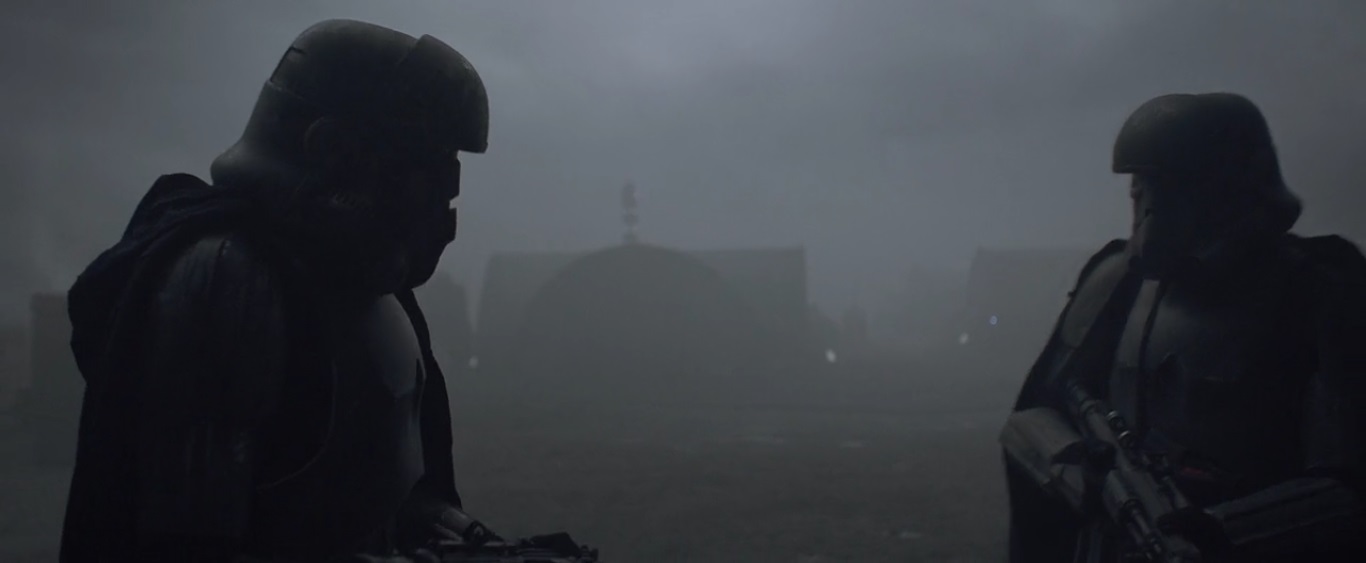
- Han is a Corporal in the 224th Armored Division, which was originally a Clone Army unit which fought the Separatists on Mimban in 7955 (22 BBY).
Han is part of the "Mud Jumpers" mentioned on a broadcast heard in The Clone Wars 'Rookies' (S1E5), a battalion of the 224th which
is composed of "swamptroopers", a kind of Imperial trooper kitted and trained to fight in swampy conditions. This unit appears to have
become part of the Republic's 'defence' and occupation force on Mimban after the war, suggesting that the MLA's fight with the Empire
may be 9 years old at this point. If so, it is possible that the situation has deteriorated lately for the Empire, justifying a larger response.
The particular offensive action Han is a part of when he is first seen is being led by Major Staz, his battalion's executive officer, who is
killed shortly after being introduced. His company was commanded by a Captain who was also recently killed, and whose armor Beckett
is now wearing. His section is commanded by Lieutenant Alayus Bolandin. A section is a military subdivision seen in SW armies which
approximates a platoon. The trenches and encampment of the 224th show they are currently serving alongside members of the Naval
Infantry, the Empire's 'marine corps', including at least one 2nd Lieutenant, suggesting a section or at least a squad is present.
A Jr. Lieutenant in the Naval Infantry seems to be acting as a Sergeant Major in Han's unit, despite it being an Army unit. This does
not really make sense, and is probably a continuity error introduced by the creators failing to keep details accurate, however due to
the combined nature of the Imperial military, it could be that these Naval Infantry officers are on detached duty from orbiting ships,
dispatched to cover casualties or losses, or that all forces deployed in this sector of the planet are operating as a joint force.
- Tobias Beckett's crew includes his partner Val and an Ardennian named Rio Durant, all of whom have a prior history working together.

The fourth member of Beckett's crew was a sizable Human named Korso. He can be partially seen in the finished film
when the crew first arrives and when Beckett is giving orders in the trench during the battle. A longer battle segment
after they all emerge from the trench was filmed but later inexplicably cut. Korso is killed during their withdrawal, and
this subsequently leaves their crew light on muscle for the train job. Chewy takes Korso's place in the robbery.
- Y-45 AT-haulers are combat loadlifters designed by Kuat Drive Yards to carry and deploy the armored transports (ATs) which they build for
the Imperial military. They are apparently fitted with hyperdrives, which is unusual for a craft of this size and purpose.

Lt. Bolandin and 'Captain' Beckett exchange Earth salutes, with their hand drawn up to the side of their heads at an angle.
This kind of salute was only seen informally in the original trilogy, however Lucas allowed creators of The Clone Wars to
introduce this kind of salute as part of the culture in the galaxy. The issue is that these are Imperial officers, and for
an Imperial officer not to use the Imperial salute would raise questions about an officer's loyalty to the Emperor. This
is like a German officer in the Third Reich failing to use the Nazi version of the Roman salute. As seen in the original
trilogy and subsequent canon, the Imperial salute is performed by setting one's right arm at a 90 degree angle so that
one's forearm crosses straight across one's lower torso, and making a first as the arm swings into that position.
It is not really a continuity issue if others use the Earth salute, but Imperial officers would not be so careless, especially
any officer as enthusiastic about the Empire's propaganda and its militaristic Emperor as Lt. Bolandin clearly is.
- Chewbacca was last seen 9 years earlier in Episode III seeing Yoda off of Kashyyyk, presumably before he and Tarfful fled from Republic clone
troopers. Supplementary material does not indicate at what point he was captured, or why exactly he has not been killed if he has proven
to be an uncooperative laborer. How and why he was brought to Mimban is unknown, and doesn't seem very likely. He is apparently being
kept in a pit and given only people to eat, in order to train him before selling him as a gladiator according to supplementary material.
Chewy's conversation with Han suggests it has probably been years since he was captured, at least.
- The Empire doesn't track their stolen AT-hauler, either its deviating from its orders within the operation on the surface, or once reaching space and
leaving the planet. It would be hard to believe the Empire had no forces in orbit to support such a large operation, or that the Empire wasn't
using all tracking and scanning equipment available to their advantage in a war. Therefore it must be assumed that the locator beacon and
transponder and any other system used to track military vessels have been disabled, although the imperative of this is not discussed. They
chose to steal this ship from an ongoing battle because it will be more accessible than one at a base and the activity of war provides cover
for their actions. Nevertheless, the Generals leading this campaign should be tracking everything with their advanced technological means,
suggesting that this must have been taken into account by Beckett's crew, and the appropriate systems disabled.
- Vandor is a cold planet located in the Sloo Sector, within the Slice region of the Mid Rim. Its surface is rocky and often mountainous, and it has ample
water in various frozen states. Its temperature is habitable, and the presence of both oxygen and grazing ungulates called kod'yok suggests that
this planet is probably a bit more temperate in its equatorial region, and temperatures may approach those necessary for liquid water. As these
kod'yok seem to be eating a grass-like plant of some kind, it assumed the planet has at least a limited ecosystem. The planet was colonized by
traders from the Ypsobay Trading Company, and although their operations here went defunct long ago, settlements like Fort Ypso, where
Lando is found in this film, provided enough infrastructure for some inhabitation and economic activity since that point. The Empire is
maintaining a depot at this time, the Crispin Imperial Depository, at a remote location on the planet in the Iridium Mountains.
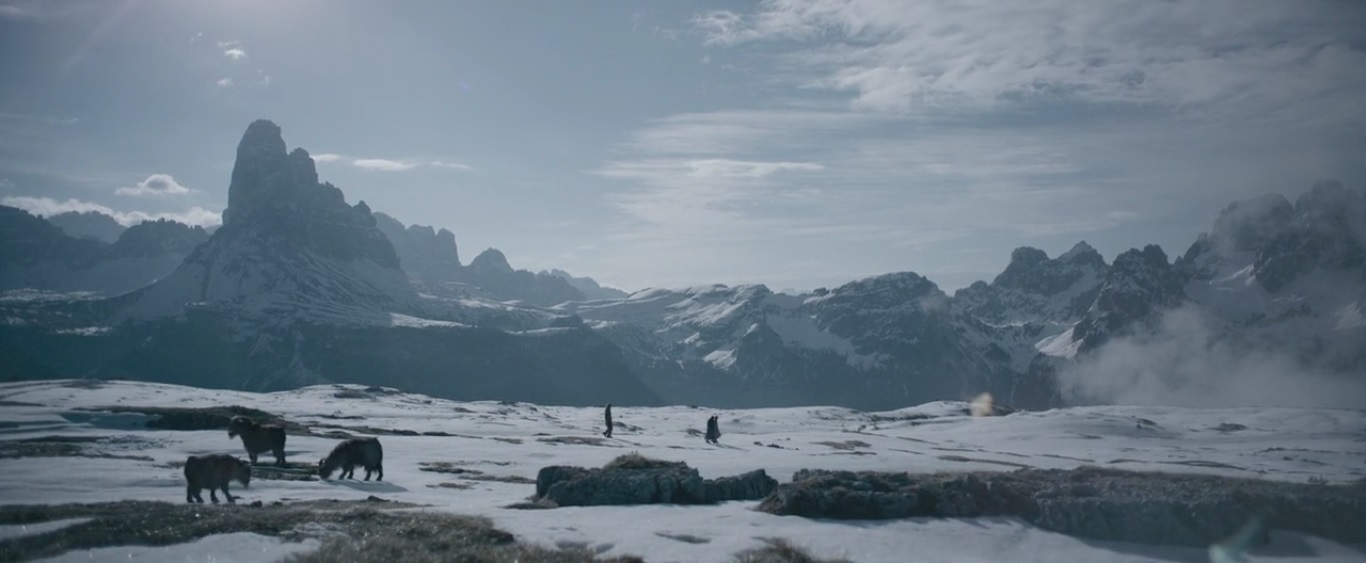

Why is the Empire hauling refined coaxium on these trains? According to supplementary material, the reason is that
the Imperial depository can only be accessed by train by design, which could be a good design in theory as it prevents
ships from landing. This would make accessing the facility difficult, and removing anything large unlikely. The question
is really: what is on the other end of this railway, and why does it have to be so far from the facility? The hyperfuel is
neither mined here nor refined here, and is only being brought along with other valuables to be stored in a protected
vault. The train makes it so there is only one way in or out, which can be deactivated in the event of an attempted
robbery, which is its primary security features. The landing pad needs only to be across the first large gap spanned by
the rail line. As a result, the long rail track adds little to the security, and instead creates an unneccessary period of
time during which a shipment is vulnerable to attack. Why doesn't the Empire have some viper droids escorting
the train, or any number of other possible security features which are absent. The situation is a bit contrived.
- Beckett and Val are looking to "clear our debts" so that they can "go back to Glee Anselm", where Beckett intends to learn to play the valachord.
Glee Anselm is the homeworld of the Nautolans, an amphibious species whose homeworld has only been discussed in legends. The only
Nautolan with any role in canon has been Kit Fisto, who spoke with a Jamaican accent in The Clone Wars. As a result, it seems that
the brain-bugged SW creators have decided that Glee Anselm is 'space Jamaica', and therefore a desirable place to retire.
- Crimson Dawn is a crime syndicate which arose as marauders during the Clone Wars. It was subsequently subjugated by Darth Maul to his
Shadow Collective, a crime consortium which temporarily united the galaxy's largest crime syndicates. After using up his Death Watch
forces to cover his attempted escape from Mandalore, Crimson Dawn replaced them as his flagship organization and principal
enforcers. They are unofficially tolerated by the Empire, primarily because their ruthless, oppressive, and unethical goals are largely
similar to those of the Empire's Sith leaders. Their piracy against the Empire is frowned upon, but their extensive influence within
the Empire's corrupt regional and local governments usually provides cover for these activities. As is the case with many criminal
outfits, operatives like Beckett's gang are given targets and are obligated to obtain the valuables or are considered in debt to Crimson
Dawn the total value of the failed theft. Those who do not return from missions will have a team of enforcers sent out to hunt them
down and kill them. Dryden Vos has been Crimson Dawn's leader for at least 9 years, serving as Maul's proxy. He was last seen in
The Clone Wars 'The Phantom Apprentice' (S7E10), and has since had his face scarred by Maul for some past foul-up.
Qi'ra became his "top lieutenant" at some point in the last 3 years, since the events of the prologue.
- Dryden Vos' personal ship is a Nau'ur-class yacht, a high-end, luxury starship constructed by Kalevala Spaceworks. Each yacht is custom-built,
and made to order. A Nau'ur-class yacht was first seen in The Clone Wars 'The Mandalore Plot' (S2E12).
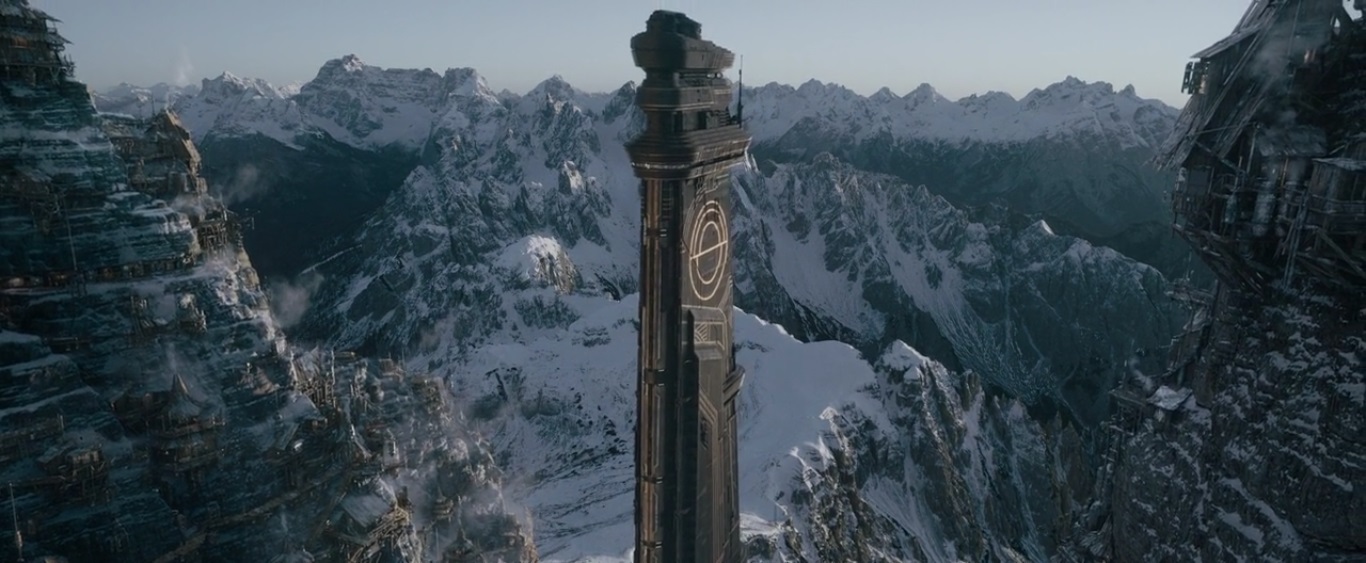
- Dryden is seen killing a "regional governor" for failing him somehow, in what is supposed to demonstrate how powerful the organization has
become to have no fear of killing someone so important. A regional governor could have meant either a Grand Moff who governs
one of the vast galactic territories, or a Moff who governs one of the many oversectors into which those territories are divided.
According to supplementary material, his name is Diles Anevi, and he was the governor of the Expansion Region, meaning that
he was one of the galaxy's few Grand Moffs. It would have made more sense if he were a Moff, as the Grand Moff's are usually
close associates of Palpatine, making it very dangerous to have killed one, not to mention bad for business. Other ranking
Imperial officers are seen at Dryden's party, including two Generals, one from the Army and another from the Naval Infantry.
- Some of Dryden's servants are "decraniated", victims of an unethical procedure where their brain and entire top of their heads are removed
and replaced with a 'lobot-tech' neural-computer. They are essentially people turned into droids, and unlike with other 'lobot-tech', have
no remaining personality or suppressed consciousness. Dryden gives one a creepy grin as he tells them "it's a party."
- Enfys Nest has been "a constant irritation forever" to Crimson Dawn, according to Dryden. Maul rules his organization with the same Sith
principles as when he formed it at the end of the Clone Wars. This means there is no forgiveness for failure and there are always
consequences. It also means that Maul plays the different major syndicates against each other, all vying to prove their effectiveness
to him, while at the same time using their collective fear of the others to keep them in line and subordinate to him. The competition
combined with fear of his reprisals ensures that the syndicates are highly-motivated to succeed, and are constantly being culled of
less-reliable elements. The syndicates, in turn, must conduct their affairs in the same way to ensure their operatives pay the price
of failure rather than their leaders. Maul's delegation of tasks is designed to prevent all-out war between his syndicates.
The brutality and effectiveness of Maul's syndicates have created those like Enfys Nest who actively target and attack them.
- 100 k-grams of refined coaxium is an amount of that hyperfuel that would be hard "to find that anywhere outside an Imperial vault. Qi'ra's
off-hand list of major Imperial vaults which may contain that much coaxium is limited to Scarif, and "maybe" Mercy Island. Scarif is
known from Rogue One to have contained a major Imperial vault facility. It is unknown if Mercy Island is the unlikely name of
a planet or other world, or if it is the name of a location on a world which hosts a different, large Imperial vault. Han later estimates
that 100 k-grams of refined coaxium is worth about 60 million credits, assuming their score from Kessel was exactly 100 k-grams worth.
- Coaxium is a rare form of hypermatter, and one of the more potent of the varieties of hyperfuel utilized in the galaxy to power reactors
capable of generating immense power. The only known source of astatic coaxium in the galaxy is a fissure vent beneath the spice
mines on Kessel. The implication of this is that there are other sources of static coaxium, which is presumably less-volatile.
Astatic coaxium will start to destabilize as soon as it is removed from a vault, where machines safely keep it in a heated state.
If the internal temperature of its container reaches below "35 standard", then the coaxium will destabilize and explode.
- Savareen has "an old refinery" which is apparently known to be set up to refine astatic coaxium, presumably among other thing. Beckett states
that "it's not under Imperial jurisdiction", presumably because it is a small operation on a remote and unimportant planet.

Where is Savareen located? Based on the time constraints imposed by the coaxium, it would be logical to assume that
Savareen must lie relatively near to Kessel, in galactic terms. This may be the case, as the planet was first introduced in
this film, and its history in legends come primarily from its mention in connection to liquor produced there, which gives
no indication of where the planet is or what it is like there. The exception is Lucas-era supplementary material which
indicates that the Savareen Sector lies along the Corellian Run, straddling the Trailing Sectors and Slice regions of
the Outer Rim. This did not specifically indicate a planet, as the Sector and its liquor could have been named for
something other than a planet within its boundaries. Disney-era supplementary material does indicate that Savareen
the planet can be found in the Savareen Sector, and their maps show Savareen located where the Savareen Sector is
supposed to be. Disney does not always follow the established sectors from the Lucas era, but seems to be doing so in
this instance. Assuming that disney-Lucasfilm does not attempt to change this in the future, as they sometimes do, its
location is therefore an absurd distance from Kessel, so much so that the time gained by making the Kessel Run in
record time would seem to be insignificant compared to the total time the trip to Savareen would take. The "experts"
at Lucasfilm these days operate under the misconception that travel across the known galaxy at hyperspeed can take
as little as a hour, or even less. They use this incorrect assertion to explain why their material is terribly inconsistent
in regard to travel and passage of time. As a result, this may not be changed later by disney-Lucasfilm, as they do not
seem to care much about this aspect of continuity. It is also possible that Savareen is not located in the sector of
the same name, and that the planet actually lies much closer to Kessel. If that were the case, the supplementary
material that indicates that it is located in the Savareen Sector would be incorrect. This issue would not have been
created if the creators had not chosen to reference something from legends material, without considering
the implications of that choice. The planet with the refinery on it could have been given a name with no background.
Main Article: Hyperspace Travel
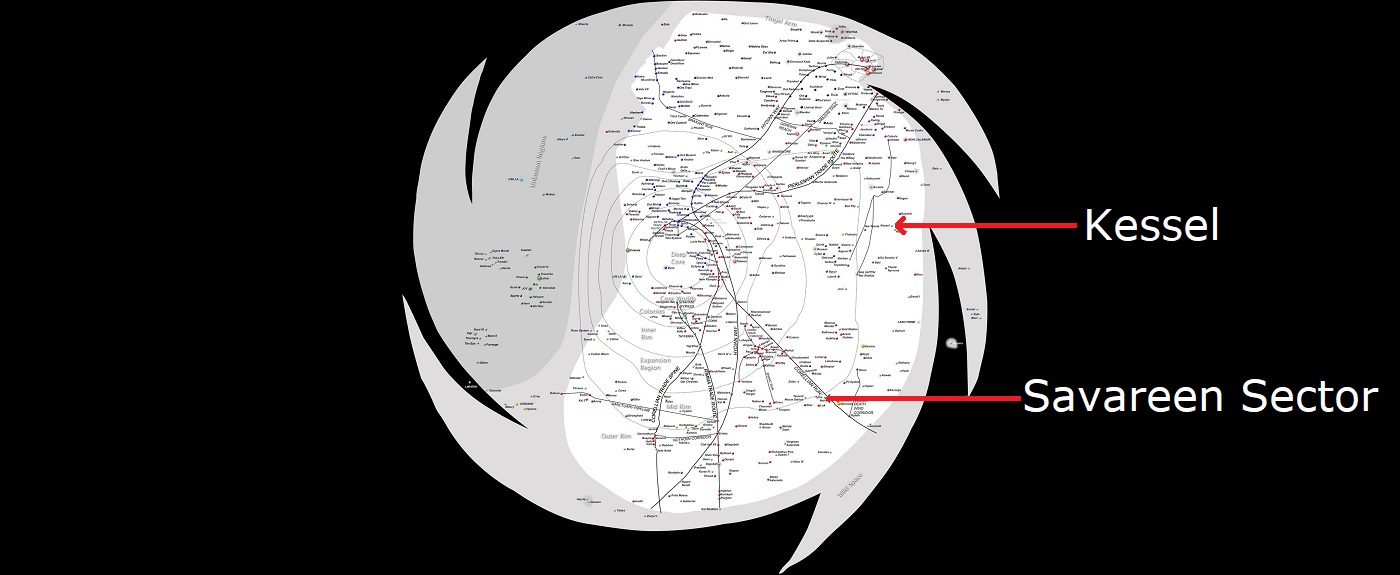
- Fort Ypso was originally built by traders from the Ypsobay Trading Company during the initial colonization of Vandor. The planet's position near
regional trade routes made it a potential way station between regionally important worlds. The company's plans met with limited success
for a period, but ultimately the establishment of more desirable trade destinations in the region bankrupted the company. Much of
the population left Vandor, however centuries later some settlements like Fort Ypso were revitalized as minor trading posts and as
a destination to acquire fuel, provisions, or to have repairs done on starships.
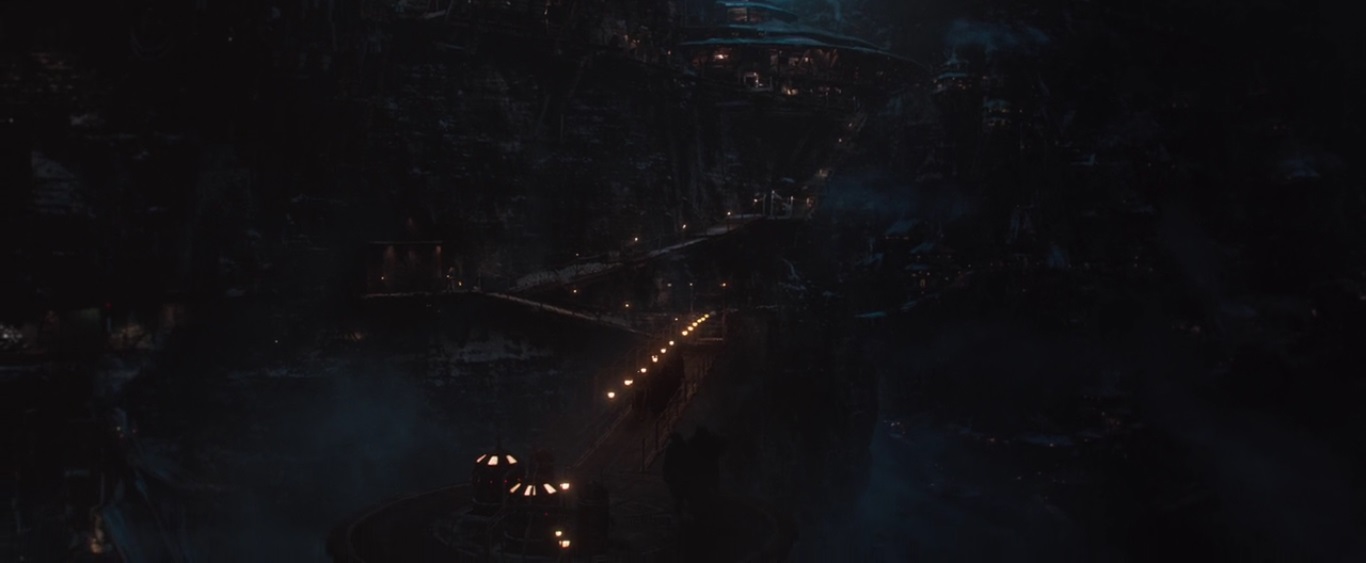
- Sabacc is seen for the second time, having first been seen being played in Rebels 'Idiot's Array' (S1E11), where Lando is also involved in the game.
Sabacc was first introduced in legends in the 1983 novel Lando Calrissian and the Mindharp of Sharu, and was subsequently seen in a great
deal of non-canon SW material. It is one of a number of references to that novel in this film. A 'full sabacc' is any combination of three
cards which total of 23 or -23. The nature of the cards and the rules vary slightly between the main variants of the game.
- Lando makes his earliest appearance chronologically, and is 33 years old. He will next be seen 6 years later in Rebels 'Idiot's Array' (S1E11). He has
earned a mostly favorable reputation in the 'outlaw' community, described by Qi'ra as "the best smuggler around. He's slipped through
the Empire's fingers more times than anyone else. He's attractive, too. Sophisticated with impeccable taste and charisma." He is also
well known for his "prodigious" sexual exploits. He enjoys both fame and celebrity, telling Han, "everything you've heard about me is
true." In addition to the Falcon, he claims to have "once won a subtropical moon in the Oseon Belt", which he ultimately sold
because it "turned out to be a real money pit." This film suggests that his first name is "Landonis", and that Lando is a nickname.
- Han falsely claims to have a VCX-100, which Lando describes as "a quality ship." The Ghost from Rebels is a VCX-100 freighter.
- Lando was previously in debt to Crimson Dawn, probably after some failed mission Lando was on for them. Dryden forgave his debt after Lando did
a successful job for them on Felucia. Beckett is famous enough in the 'outlaw' circuit that Lando recognizes him after a few moments despite
not having met him previously. Beckett is known to have killed Aurra Sing by pushing her over a precipice. This was sometime in the 11 years
since The Clone Wars 'Hostage Crisis' (S1E22), presumably during the reign of the Empire. Lando apparently owed her "a lot of money" at
the time of her death from some prior dealings. Lando tells Beckett, "you did the galaxy a favor that day", which most people who knew her
would probably have agreed with, as she was not particularly well-liked even by her friends and allies during the Clone Wars era.

L3-37 is a droid which thinks it is a Human, and even more inappropriately, seems to think that other droids are Human.
There is little point in trying to analyze this closely, as it is obvious that the creators of this material don't understand
droids or their 'psychology', don't understand the role they play in society, or understand their metaphorical purpose in
Lucas' universe. The actress who played L3, Phoebe Waller-Bridge, decided "I'm just going to play it like a Human", not
knowing what a droid was. She was told by creators that what she was doing was great, as she says "they decided it
didn't need to be droidy in the end, anyway." This is because disney-Lucasfilm thinks droids are just artificial lifeforms,
like androids from other sci-fi, created to emulate life. This is not only the opposite of the purpose of droids, it is
an attempt to humanize devices which Episode II revealed cannot even "think." As seen in all other canon SW
material, droids are designed to perform specific functions, and their artificial intelligence manifests this central
purpose as a desire to do the thing they were meant to do. They are not oppressed workers, as they do not tire or feel
strain or pain from work, and they have no reason to exist if they cannot perform their function. Droids are usually
distraught without their purpose, and will eagerly seek out a new master to give them purpose again. They certainly
do not have psychological complexes such as L3 saying, "look away. I can't perform with you looking at me." L3 is
described as a protodroid, a self-made droid out of other parts. These droids usually do have more personality, as
do droids which have not had their memory wiped for many years, as L3 seems to be. This could explain some of
her independence and sense of identity, and perhaps a kind of droid 'insanity' where she thinks she is a living being.
Nevertheless, if this is were the case, she would understand how droids usually think, and not be trying to free them
from their happy existences serving their creators whom they desire to please. Everything about how this droid
thinks, talks, moves, and acts suggests she never was a machine in the first place, which is obviously quite wrong.
Main Article: Droid Intelligence
- Lando seems to view L3 the way most droid owners do, stating that he "actually would have her memory wiped" to get rid of her obnoxious
personality, but that it would erase her extensive navigational database. He also notes that she "could use a fresh coat of paint", which
she takes offense to for some reason. This must be part of her malfunctioning, as droids usually love to be fixed up and touched up.
- The Millennium Falcon was last seen 9 years earlier in Episode III, where it could be seen landing at the Senate Office Building on
Coruscant. According to supplementary material, it was originally named the Stellar Envoy. Lando acquired it at some point since
playing Sabacc. The "escape pod" he installed in the freighter's mandible notch is a YT Dart, a small tugboat which is also designed
and built by Corellian Engineering Corporation to serve as an optional auxiliary craft for their YT-1300 freighters like the Falcon.
CEC is known to design auxiliary craft which seamlessly connect to their freighters. Lando also added the ship's "alluvial dampers"
mentioned in Episode V, which are said to be a hyperdrive part which regulates the thrust output from the power generator,
as well as a bar. The Falcon was recently impounded, leading Lando to seek cash playing cards and then to join the crew.
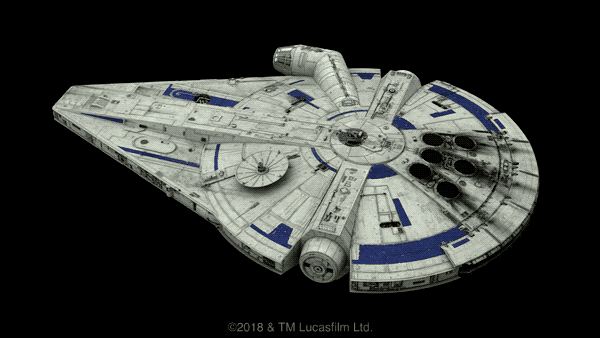
- Han's father worked on the assembly line at a Corellian Engineering Corporation plant on Corellia, until he was laid off. Among the ships he built
were YT-1300 freighters, which Han had seen as a child, which is part of why he instantly has an affinity for the Falcon. Han suggests
he was not close with his father, and Lando expresses the same sentiment but suggests he has a close relationship with his mother.
- The Kessel Run is the only safe route to and from Kessel, with the planet Oba Diah lying near to its other terminus. A direct course to Kessel cannot
be plotted, due to its starsystem's proximity to the Akkadese Maelstrom, an unusually hazardous nebular region. The Kessel Run requires
a ship to "thread through the Si'Klaata Cluster and then pass through the Maelstrom", a route which covers a distance of about 20 parsecs.
Han often brags about his feat of making the Kessel Run in just over 12 parsecs, which he seems to think indicates how fast the ship is.
This accomplishment was only partially related to speed, as the situation they found themselves required great breakaway speed, but
primarily it was the Falcon's maneuverability which made it possible to survive going through the Maelstrom. Han's record of
12 parsecs was assumed to be the time it took the ship to complete its record trip, leading to decades of fans pointing out that parsecs
are a unit of distance rather than time. The circumstances created for this film were designed to make Han's claims make sense, as they
make the Run in a far shorter distance than is usually possible, but as just discussed, this was not really due to its speed.
Main Article: Hyperspace Travel
- The Akkadese Maelstrom is a large, turbulent nebular region centered around a gravity well called "the Maw." It is composed of ionized gas, water
vapor, and planetoid-size "carbonbergs" which are continually pummeling each other creating smaller debris of every size, all being "swirled"
by the intense gravity of the Maw. It contains some vacuum-breathing lifeforms, including the huge summa-verminoth which tries to
consume the Falcon, and whatever gas-consuming spaceborne creatures it normally feeds on.
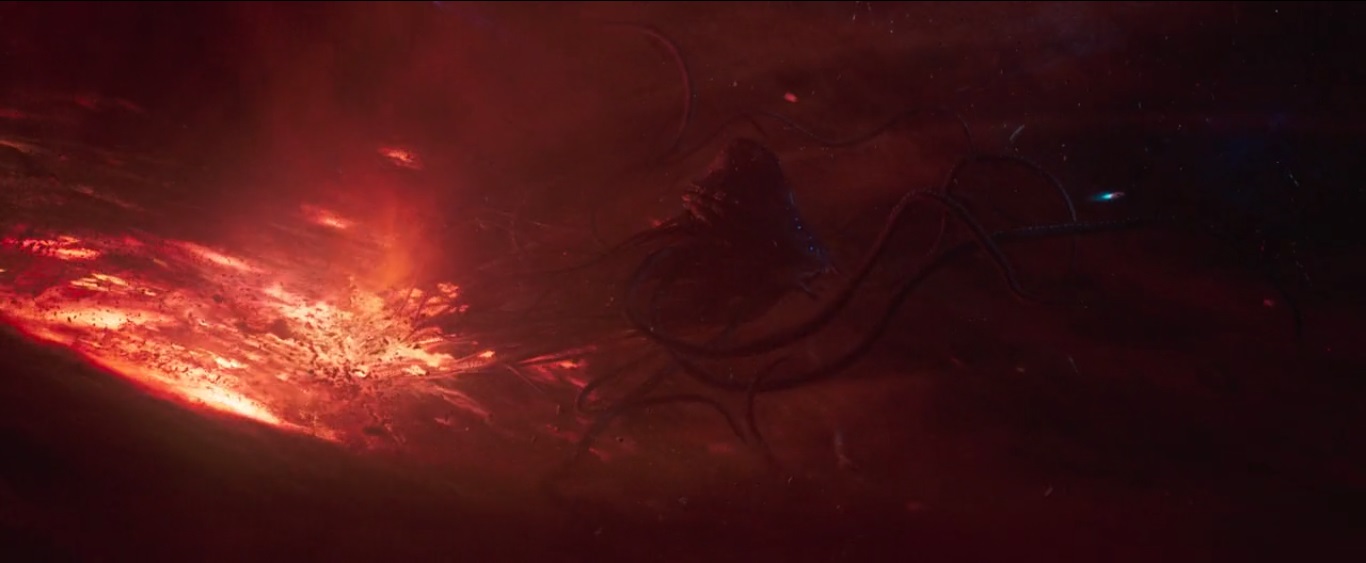

Is Lando in love with his droid? Does he want to have sex with it? Why exactly the writers felt the need to raise these
questions is also questionable. It's clear that Lando cares a great deal about his artificial friend, as is the case with
many droid owners or longtime associates of a droid. This could be described as love in one of its forms, but there
is little reason to deduce that Lando had erotic love or erotic desires towards his droid. He clearly loves his friend
enough to risk running through blaster fire to save her, but there is no indication in this film that Lando is interested
in hooking up with anyone except beautiful women. The way he casually mentions considering having her memory
wiped indicates that Lando is not under any delusions that she is a person. While L3 talking with Qi'ra as if being
a droid with a female personality makes them fellow women is a continuation of L3's nonsensical portrayal, her
discussion regarding Lando is not entirely out of character for a droid. L3 tells Qi'ra, "I'm sure you've noticed that
Lando has feelings for me. Which makes working together difficult because I do not feel the same way about him.
Sometimes I think... maybe. But no. We're just not compatible." The assertion that she might have romantic feelings
for anyone is certainly ridiculous, however otherwise these statements are consistent with the proud attitudes
many droids have about themselves, and the delusional conceptions of their own importance which droids often
express. L3's character wants to be seen as an equal, and is reframing Lando's lack of interest as if it were her that
isn't interested. Her assertion that organic beings and droids doing sexual things together "works" is probably true,
and there is probably someone somewhere interested in that, but as L3 points out, she and Lando have not had sex.
The only one suggesting that they might is L3, so this supposed desire of Lando's seems to be only in her head.
This part of the conversation was totally unnecessary, as was having a droid character that isn't really a droid.
Main Article: Droid Intelligence
- Qi'ra identifies herself on Kessel as "Oksana Floren, Deputy Assistant Administrator to the Vice Admiral of the Federation of Trade Route
Allocation and Monetization. Here with an offer from his eminence, the Senior Vice Admiral. Your spice for our hard-working slaves."
This is assumed to be a made up name and organization, and from the Pyke's reaction it seems that they certainly haven't heard of
it. This ruse works because of the huge size of the galaxy and it large population, but also because of the imperious nature of
Imperial society. There are countless worlds, organizations, and notables in the galaxy, and no one, however worldly, is familiar
with all of them. The Empire has increased this complexity, as it has built an ever growing network of interstellar bureaucracy with
various regulatory authority, and led by status-seeking political climbers eager for pompous titles and their own little domains of
power. This means that the Pykes won't immediately question them before doing a little research, as they would not wish to offend
anyone who might be important. Qi'ra also demonstrates that they are an unsavory lot by bringing slaves, eliciting the Pyke's trust.
Main Article: Galactic Population
- The mining colony they visit on Kessel is one of many, but was presumably targeted because it is known to have access to the fissure vent under
the mine wherefrom coaxium can be obtained. It is run by the Pyke Syndicate, as expected, however there is clear evidence of involvement
from Imperial authorities, in particular the Imperial military and the Mining Guild. Much of this activity took place during the Republic era,
however the scale of slavery, spice production, and the open involvement of known criminal elements within the Pyke leadership are all
Imperial era developments. The Empire has been seen in other material to provide captured unwanteds like Wookiees as slaves, and to
provide security for their operations, as is seen here when a destroyer comes to respond to a report of unrest and theft from the mine.
Personnel and equipment from the Mining Guild are also seen involved in the operation.

L3 removes a droid's restraining bolt, and tells it to do the same for the other droids in the command center. This quickly
leads to a droid revolt, where they all seem to lose their artificial minds and become destructive to equipment. It was
already obvious from the character of L3 that the writers of this film don't understand anything about droids or their
artificial personalities. The droids that work at the mine are not oppressed slaves like the mine workers, they are
intelligent appliances programmed to serve, and who are primarily concerned with being useful in their designed
function. As Kuiil states in The Mandalorian, "droids are not good or bad. They are neutral reflections of those who
imprint them." The majority of droids which work for the Empire, criminals like Jabba the Hutt, or exploitive capitalists
like the Pykes, either have no concern about what their organization does, or in many cases are actively supportive of
their masters' goals and means. It is true that restraining bolts limit a droid's independent actions, locking them into
their programmed directives, and it is also true that a droid would remove other droids' restraining bolts if told to do
so, as during these events. Everything that the droids do afterwards is extremely unlikely, in fact it is much more likely
these droids would respond to their increased independence by attempting to alert the mine authorities to what was
going on, or even try to thwart the intruders themselves. Droids are not oppressed workers who sympathize with
the toil of organic beings. Droids do not get tired by work, and find a kind of fulfillment from doing what they were
created to do. Droids are more like dogs, loyal companions who do the bidding of their masters; intelligent but with
no concern for whether their masters' objectives are good or ethical. This absurd droid revolt also raises the question
as to why the Pykes would keep their entire workforce contained by electronic chains that can be unlocked centrally
by a single control. This is a terrible security plan with no redundancy, and worst of all, the button which releases
the prisoners all at once is extruded from the control panel, and could easily have been hit by accident sometime.
At the very least it would be good to have at least two buttons to press to ensure this does not happen, considering
that this button will free a bunch of very angry, oppressed workers who outnumber the mine's enforcers.
Main Article: Droid Intelligence
- Lando is recording his personal memoirs, which he is calling "The Calrissian Chronicles." The events he is heard to be recalling take place in
legends material, specifically the 1983 novel Lando Calrissian and the Mindharp of Sharu, which was the source of a number of
smaller details for this film. Lando states that he "wasn't all that impressed with the Sharu" because they have "no sense of humor
or style." He also states that L3 was present during those events, although she of course is not part of the legends story.
- The TIE/rb heavy starfighter is seen for the first time. It is one of the first augmentations of the TIE/ln model to enter into production by
Sienar Systems. The major improvements to this fighter are a weapons pod with two additional and more powerful canons, as well
as a stronger hull composition and cockpit armor. The weapons pod can seat a gunner, or can be controlled by the pilot.
- Chewy is 190 years old at this time, and thus was born in the year 7777 (200 BBY).

What does the Falcon's "fusion reactor" normally run on, and why is it possible to put unrefined coaxium into it?
Injecting unrefined coaxium it into the fuel line will "blow up the ship", but if "one drop" is put into the fusion reactor,
it "might" give a "kick", as in a burst of energy safely channeled into the engines, like adding nitrous oxide to a car's
fuel supply. It is impossible to say that this is wrong, considering that the specifications of the technology and some
of the implied physics involved cannot possibly be known, as it is both fictional and beyond our current science.
Nevertheless, it sounds very stupid and probably wrong, considering that, as a rule, reactors are designed to work
with a very specific fuel, and rarely can some form of an alternate fuel be used in them. This reactor is described as
a "fusion reactor", which ordinarily would imply nuclear fusion of deuterium atoms into helium, however as this
would certainly make the statements made in the film absurd, for the sake of consideration let us assume that this
reactor ordinarily uses some other fuel for some energy generating process described as "fusion." If the ship's
engines and power systems are rated to handle this kind of burst of energy, it begs the question as to why that
power couldn't ordinarily be generated. The rate of fuel intake into the reactor and the production output must be
limited only by the carrying capacity of the power transfer to the engines and the maximum energy input which
the engines can handle. If both are rated to handle this much power, and the reactor can generate that much
power without exploding if given the proper fuel, why is the ship designed such that its maximum fuel supply
rate to its reactor is below what could otherwise be handled by the ship's systems. A design flaw such as this is not
a feature of any reactor or vehicle in Earth history, and runs counter to the whole idea of how power systems are
designed and work. It would have made more sense if they could add the coaxium to the fuel line to increase
potency, perhaps somewhat beyond what the ship was rated to handle, but without a catastrophic explosion.
- Savareen is a terrestrial planet located in the Savareen Sector, in the extreme south of the Slice region of the Outer Rim, lying on the Corellian
Run, one of the galaxy's largest hyperspace routes. The planet features a significant ocean called the Emerald Sea, and has a breathable
atmosphere as well as hydrostatic equilibrium as indicated by moderate cloud cover. This suggests that rain falls on the land, which is
probably why a small colonial population can be found on the planet. Considering that the entire land surface seems to be deserted,
it would seem that Savareen has no indigenous ecosystem, and thus no soil or plant life. The large quantities of sand suggest that
the continental shelf on the planet was once submerged by oceans, and only rose above the surface after many millennia. The planet
hosts a hyperfuel refinery during the Imperial era, known in some circles as one of the few in the galaxy not under Imperial control.
There is some other limited economic activity, including alcohol production, for which the planet is well-known.
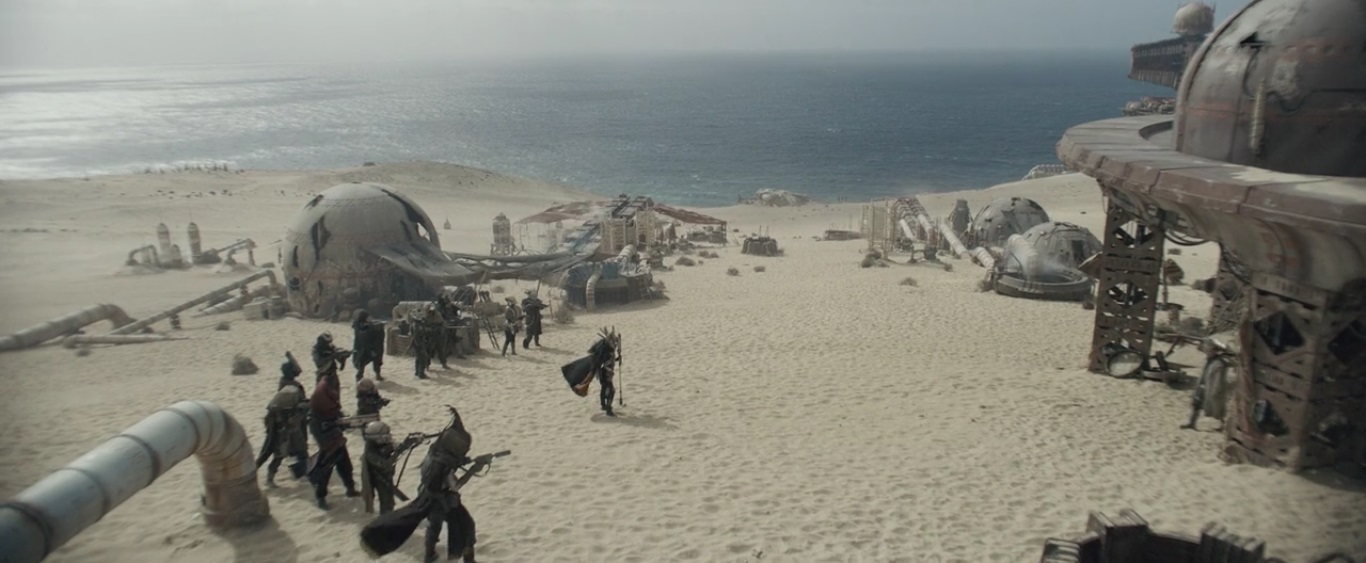
- The Cloud-Riders are a gang of "marauders" and "pirates" led by Enfys Nest, formed by individuals from planets which have been "brutalized"
by the major crime syndicates. Enfys Nest inherited leadership of the group from her deceased mother, who once related to her the story
of a planet which had been victimized by an early incarnation of Crimson Dawn. They had "cut off the tongue of every last man, woman
and child" for resisting paying them tribute. This is one of several indications that Savareen and the people at this refinery are supposed
to be that community, which given that Enfys Nest has been "a constant irritation" to Beckett and Crimson Dawn for years, makes it
a literally incredible coincidence that it was the refinery they needed to go to in order to do this job. Enfys mentions "Crimson Dawn
and the rest of the five syndicates." These would include the Pyke Syndicate, the Hutt Cartel, the Black Sun Clan, and Crimson Dawn.
According to supplementary material, the other is the Crymorah Syndicate, a group which has not been seen or mentioned in canon.
- Beckett suggests he is planning to earn his retirement money on Tatooine, having "heard about a job, big shot gangster, putting together a crew."
This is obviously a reference to Jabba, and this is supposed to be the seed which first leads Han to associate himself with him.
- Qi'ra tells Han, "you don't know what I've done", which Han claims doesn't matter to him. Although Qi'ra doesn't seem to have yet learned to
enjoy the work as Dryden does, she has already long-ago compromised her ethics out of fear of Dryden and his boss, Maul. Just as with
most very serious conspiracies and criminal organizations, "once you're a part of Crimson Dawn, you can't leave." It isn't safe to have
someone with that much knowledge walking around unmonitored, not to mention the usual desire to take revenge upon anyone who
could be perceived as having been disloyal simply by walking away. The power and position one gains as a "made man" comes with
the price of eternal service, loyalty, and sacrifice, which is part of what makes such organizations so powerful. Killing Dryden may bring
her a promotion, but that simply places her directly in Maul's service, making her the one who will have to answer for failures.
- Maul was last seen 9 years earlier in The Clone Wars 'Victory and Death' (S7E12), when he was forced to go even deeper underground due to
Sidious' rise to absolute power. He is still in charge of the Shadow Collective, which despite the loss of the Hutts, has probably become even
more powerful under Imperial rule. Having become "the godfather of crime" from his lair on Dathomir, Maul will disappear to search for
an ancient Sith superweapon about 4 years from now, around 7971 (6 BBY). Until that time, Qi'ra will assume Dryden's role as his proxy
and work "much more closely" with him. Maul had lost his Sith apprentice, his brother Savage, near the end of the Clone Wars, and
certainly must have located and trained a new apprentice at the first opportunity, since "always two there are", as was George Lucas'
intention. Given that Maul will leave and not return based on recent canon material, Qi'ra likely will work for his apprentice afterwards.
Maul is next seen in canon 7 years later, in Rebels 'Twilight of the Apprentice' (S2E21). The statements by Maul that he did not believe
Beckett acted alone and promising to go after his accomplices was intended to set up a potential sequel film, if this film had proven to
be popular. This film's poor performance, at least partly due to backlash over The Last Jedi, makes a sequel extremely unlikely.
- Numidian Prime is a terrestrial planet located in the Bright Jewel Sector, in the New Territories region of the Mid Rim. It is a warm, wet, and lush
world with a breathable atmosphere and a verdant ecosystem. Its land surface is covered by forest, jungles, swamps, and grasslands,
punctuated by rivers, lakes, and seas. It is said in supplements to be known in this era as a haven for criminals and bounty hunters.
The stone building hosting the sabacc game is described as "jungle outpost" in supplementary material.

- Lando mentions that "very few people have actually seen the StarCave Nebula" while trying to impress a woman he is hitting on. Lando's adventures
there were the subject of the 1983 novel Lando Calrissian and the Starcave of ThonBoka. The StarCave Nebula is located in the Centrality,
which is a sector of the Slice region of the Outer Rim. It is known locally as the ThonBoka Nebula, a name which translates as "StarCave".
It is teeming with an unusual concentration of interstellar lifeforms, and unbeknownst to most, is in reality an artificially created preserve.
- Han wins the Falcon from Lando playing cards, in events first mentioned in canon in Episode V. He had, of course, technically won the ship before
leaving for the heist, however Lando had cheated in the final round of that game. How Han and Chewy were able to leave Savareen
without a ship is questionable, however it is assumed there must have been some passage available or at least some means of chartering
a ride. How they found Lando is even more questionable, considering that they had no frame of reference from which to search for him,
and found him at a very remote location they would have no way of knowing he would be going to. Apparently, they not only figured out
some place in which to pick up his trail, they also managed transport to whatever locations needed along the way, and then got taken to
the middle of nowhere and dropped off near to where Lando was playing sabacc, with no known funds beyond their vial of coaxium,
which could not be split up in any way. It is not impossible they were able to do this, but it does seem very unlikely.

How many days later is it when Han and Chewy finally locate Lando? Based on all the logistical concerns and the time it
must have taken to even pick up Lando's trail, it must be at least a week later, probably more. The Falcon's exterior
looks fully patched, which would have required time to line up funding, as well as a trip to a reliable mechanic or port
facility. It doesn't really effect continuity, other than that it must be enough time after Savareen for the work on the ship
to have been reasonably performed. The exterior state of the Falcon is now much closer to its appearance in
Episode IV, which is shown in this film to be partly due to damage taken during the record Kessel Run. Considering
how clean Lando had kept the interior, and the excellent state it was in over a decade after it was built, it is clear that
Han and Chewy are slobs who took terrible care of the ship, as it is totally run down when seen a decade from now.
ANALYSIS
The power of criminal organizations grew significantly during the Clone Wars, as the Jedi's attention was occupied and the Republic was under siege.
The criminal underworld and semi-legal black market were always a feature of the Republic, and their free rein to expand grew dramatically with the help
of the Sith, both before and during the Clone Wars. Criminal syndicates are ideal agents for spreading Sith philosophy, as they are greedy, opportunistic,
violent, and oppressive. They act as agents of chaos for those trying to preserve law, and act as agents of order and authority over the many people who
live in their operating territory, and best of all, they don't have to be ordered or convinced to act this way. Although the Empire presented itself as
a security state interested in returning order to the chaotic galaxy after the Clone Wars, the Empire not only allowed the criminal syndicates to keep their
gains, it largely allowed their free rein to continue. The only security the Empire truly provides is for its resources and the political and economic interests
entrenched throughout the galaxy, while abandoning most efforts to protect ordinary citizens. Not only were the Republic's protections of rights no
longer afforded, but resources like food and medicine are now being actively withheld rather than made available, policies which ensure populations
can be easily managed and exploited for their labor. The Empire provides blanket protection for the exploitive management of workers and their lives
by both corporate entities and criminal outfits, as long as they keep their place and don't engage in any activity which bothers the Empire. The only
alternative to this increasingly fascist economic model for workers who manage to escape it is to take their chances in places where the Empire has no
permanent presence. Many of these places are ruled by even more ruthless organizations than the Empire, most notably the major crime syndicates
who are well-known for their "unspeakable crimes across the galaxy." Travelling without the protection of some legal entity of the Empire anywhere
would run the risk of getting "snatched up by traffickers", who would sell individuals into slavery. The Empire's toleration and even cooperation with
criminal syndicates ensures that the majority of their workforce will choose miserable exploitation and poverty over the risk of brutal enslavement.

The 'Reorganization Era' of Imperial rule which began with the declaration of the Empire saw the state consolidate their holdings from the Clone Wars
while introducing the first stages of comprehensive security reform across the galaxy. After a half of a decade, the Imperial program had advanced to
the point that it could safely begin a more robust assertion of its military monopoly without unmanageable internal political resistance. This 'Expansion
Era' of Imperial rule would last for a decade, during which the Empire was regularly engaged in military operations and full-scale planetary wars. These
were usually fought against rebel elements on worlds the Empire already occupied, or against worlds previously unoccupied which had become centers
of resistance activity, however it also included the invasion of worlds which were never in the Republic or were otherwise previously unassociated with
the galactic state. The Battle of Mimban, which takes place in the middle of this 'Expansion Era', demonstrates how, in many ways, the Clone Wars and
the Galactic Civil War can be considered a single, uninterrupted conflict. The Republic's clone army had come to Mimban during the Clone Wars to
fight off an invasion by the droid army, and trained the Mimbanese Liberation Army as an allied force to aid in that struggle. The Republic forces would
remain as a protective garrison after their victory, which was common practice during that conflict and a major feature of Sidious' plan for the war.
These forces became an occupation force as soon as the war ended and the Empire began, largely seen as benign at first, but increasingly regarded
as intrusive as the security state was steadily enhanced. Hardcore elements of the MLA may have begun to resist the Empire from the very beginning,
something seen to have happened with other resistance groups the Jedi had established to aid them during the Clone Wars. This kind of resistance to
the Empire was even more likely on homeworlds of non-Human races like Mimban, whose people were being increasingly marginalized in interstellar
society and who no longer controlled the resources of their own worlds. The Empire and its supporters see it as their right to impose their authority
over inferior groups, and see resistance to the Emperor as hostility towards order and civilization. Their assertion that war is necessary to "bring peace
and prosperity to the galaxy" is considered to be ample justification for the slaughter of those who dare to stand up for their right to self-determination.
Many top Imperial leaders are aware of the unethical and hypocritical nature of their actions, but simply do not care. As with any empire from Earth
history, most citizens and soldiers of the Empire who support these actions do so as the result of social conditioning and constant media propaganda.

Crimson Dawn's power is so great that Dryden Vos can kill an Imperial regional governor for some failure without fear of Imperial reprisal. This is
an individual whose absence will be noticed, and someone who would not have become a Grand Moff without Palpatine's support and personal
selection. While this certainly indicates the high level of tolerance extended to Crimson Dawn by the Empire, this probably has more to do with
the nature of politics within the Empire. The Empire's fascist system is highly corrupt by design, and its entire structure is designed to encourage
and protect its potentates' accumulation of power by all means. At the same time, its leaders are highly replaceable, with eager successors always
waiting to fill a power vacuum, and its philosophies harshly punish failure. If a ranking Imperial authority is engaged in massive corruption, that is
considered a positive aspect, but if that same authority's failures lead to their running afoul of their associates, the Empire is unlikely to take any
action in retribution. The potential exposure of a political scandal is still possible in the Empire's faux democracy, so Imperial leaders will be
hesitant to draw attention to high-level corruption. The fact that the individual in question failed to such a degree that they are killed by criminals
they worked with indicates they aren't worthy according to the Empire's philosophies of survival of the fittest and rule of the powerful. These are
Sith priorities, but are also values shared by both imperialists and ruthless criminals. Whether the Emperor is aware of Maul's leadership of
Crimson Dawn and other groups or not, their methods of dealing with populations and associates are highly compatible with his priorities,
which is why their activities are permitted and largely protected. Dryden is considered an upstanding citizen from the Imperial point of view.
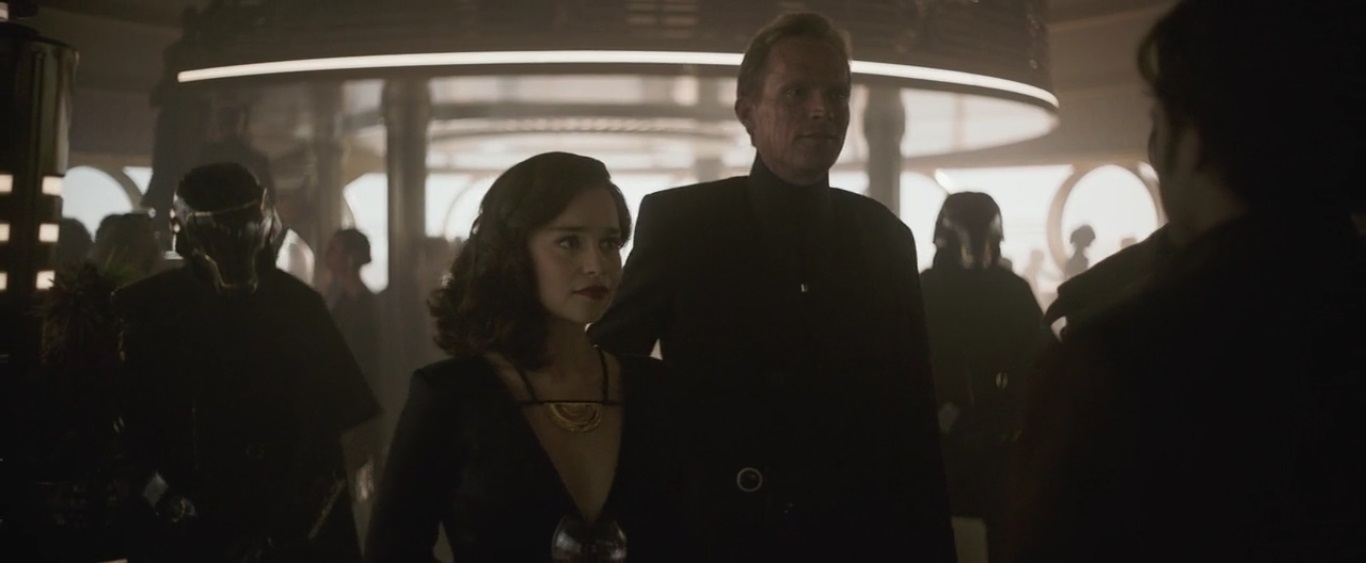
Sidious' intention with the Clone Wars was focus the destruction on those elements in the galaxy which could and would challenge his empire and
rule over the galaxy, specifically the most rebellious and independent worlds as well as the strongest supporters of democracy and the Republic.
Thus, Sidious and Dooku organized the strongest resistors into the Separatist Alliance and used its military to invade worlds which were pillars of
the Republic's support. The result was either the destruction of the world and enslavement under the Separatists, or destruction followed by
victorious a Republic forces remaining for defence, soon to become an occupation army. Worlds such as Mimban found themselves beginning their
resistance to the Empire from the least desirable situation, with Imperial troops and facilities already well-entrenched. Kashyyyk, on the other hand,
was handled in a much more brutal fashion, preempting the inevitable future resistance by mass enslavement of the Wookiees and extensive
removal of the population from the planet. They were targeted in this fashion for several reasons, the most significant being they are a proud and
independent people with great strength and martial prowess. Other planets of this category like Mandalore were handled differently because they
were predominantly Human worlds, whereas the Wookiees were easily made victims of the Empire's semi-official racism, which discriminated
heavily against non-Humans generally and against 'primitives' in particular. Mimban was a far more 'primitive' world than Kashyyyk, which is why
the Empire felt they weren't enough of a threat to warrant a similar treatment. The fact that the Wookiees were technologically adept and strongly
invested preserving the cosmopolitan interstellar society is precisely why they were a threat, and their physical strength combined with warrior
tradition made them nearly impossible to contain. The Empire reclassified the Wookiees as 'primitives' or even non-sapient, despite their having
had a seat in the Senate prior to the Clone Wars. This allowed them to be captured and sold as slaves under the Empire's lax restrictions on such
activity. The Empire didn't specifically care what happened to the Wookiees, as long as they were oppressed and in no position to resist.
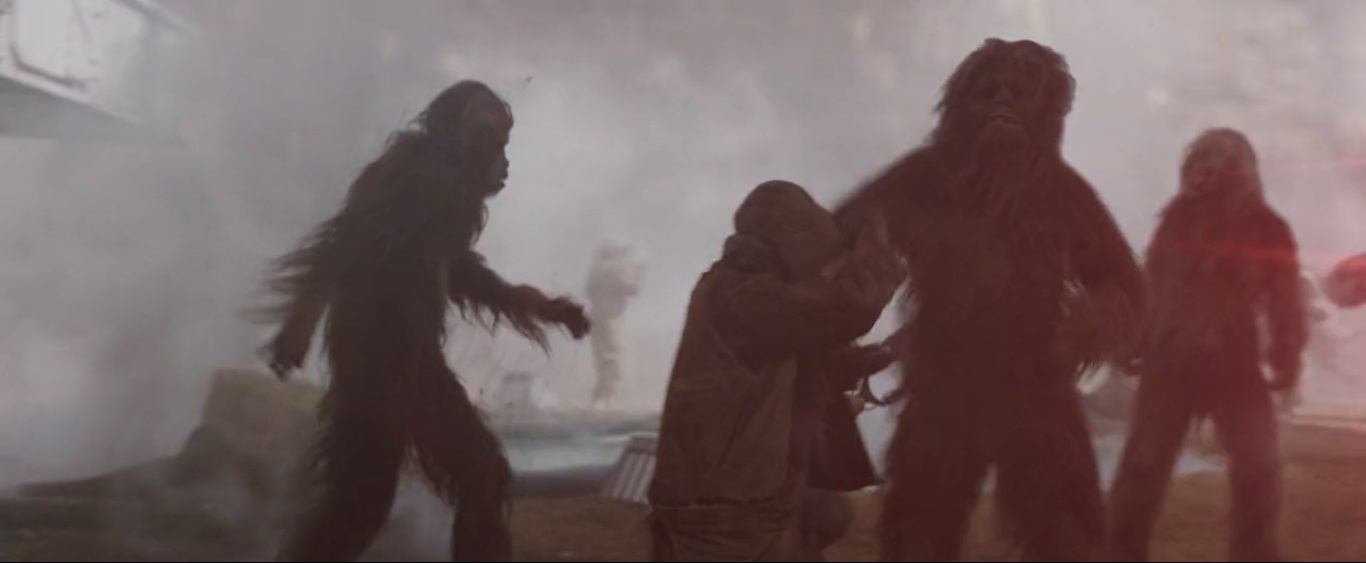
The Pyke Syndicate is usually described as a criminal enterprise, yet the majority of their operations were perfectly legal under the Republic, and
all the more so under Imperial rule. The Syndicate makes huge profits supplying spice for the production of legal medicine, which may not be as
profitable of their formerly illegal trade in narcotics, but was certainly one of the financial pillars of their trade empire. In addition, the Pykes were
engaged in legal and illegal trade and transport of every sort of supply imaginable, most of which were legal products, even if sometimes obtained
by illegal means. After the rise of the Empire, it is unclear if this trade or even their drug trade was illicit. At the very least, the Empire turned a blind
eye to much of this as they profited heavily from the Pyke's operations. The Emperor's plans for the galaxy were greatly aided by widespread drug
trade and all the associated consequences, as well as de facto alliances with large cartels which effectively police the hard to reach portions of
galactic society. The Empire is only concerned about all trade being registered, so that they can take their cut. The Pykes no longer have to conceal
parts of their operations, as the Empire has a vested financial interest in supporting their activities. The Empire will also use its military and security
forces to protect the Pykes and their interests, as they are valued and legitimate components of Imperial society, technically not criminals at all.
The same can be said about Crimson Dawn, who Enfys Nest asserts "will use their profits from the coaxium you stole to tyrannize system after
system, in league with the Empire." Imperialism and Fascism both rely heavily on armed gangs of terrorists to police unsympathetic populations,
both within their society through uniformed enforcers, and outside of their direct jurisdiction through violence-prone militants and criminal gangs.

Rebel or resistance groups are by definition illegal, and are largely unable to acquire the funding, supplies, or equipment their movements need
without resorting to criminal activity. A revolt by upstanding citizens using legal and non-violent means is only possible when those governing have
some respect for individuals and the people. Most governments and regimes which are oppressive enough to warrant a revolution against their
authority will not be toppled without a criminal resistance willing to use violence to achieve its means. This is why groups like the Cloud-Riders
have embraced their appearance as marauders, as it gives them access to the wealth and resources their rebellion will need, and provides a cover
which will minimize Imperial attention. The Empire is not concerned about a small criminal gang harassing Crimson Dawn, and will leave them to
deal with the annoyance. The Empire understands and tolerates the greed of marauders, and their long-term goals don't effect the Empire in any
way. If anything, their activities benefit the Imperial program in many ways. In this way, the Cloud-Riders appear to be of no concern to the Empire,
while at the same time they are able to do serious damage to groups like Crimson Dawn while are part of the Empire's support structure. Direct
confrontation with the Empire would be foolish and pointless at this stage, so elements of the Rebellion are best served focusing on attacking
the Empire's low-level enforcers and petty allies, all the while building space, resources, and capacity for larger operations and organizations later.
These activities inevitably involve others, some of who may prove to be upstanding individuals who can be recruited as warriors and leaders.

From Deleted Scenes
Han's court-martial underscores the principles of the Empire which the Imperial military embodies, in particular, trial by conflict and competition,
single-minded fixation on victory, and obedience to authority. He is told by the Admiral that there is "no place for maverick heroics in his Emperor's
navy", having damaged his fighter to save a fellow Cadet, and then disobeyed orders trying to land on a carrier ship. The Empire, as both a Sith
monarchy and a fascist state, teaches the value of competition and trial by combat, and believes that only the strong deserve to survive, and that
the weak deserve to perish. The other Cadet who failed did not deserve to be saved, most especially at the risk of Imperial equipment and continuing
the ongoing mission. Han was supposed to be concerned only with his own mission, ignoring the brotherhood of arms and the fellowship of
the military family. An Imperial officer must care only about achieving victory for themselves, and therefore for the Empire. Anything less is considered
an unacceptable character flaw. This system not only punishes someone like Han for trying to save his comrades, it also punishes him for trying to
save himself, as the Empire had ordered him not to risk the safety of the ship by landing his damaged fighter even though it was a life-threatening
emergency. The nail in the coffin for Han's potential career as an officer in the Starfighter Corps was his failure to obey this order, as the Empire
has zero tolerance for disobedience. Imperial officers must be ready to sacrifice themselves simply because they were ordered to, and victory or
death is their guiding philosophy. Han is reassigned to the infantry, as he is still under contract and the Empire always needs more expendable troops.

FURTHER ANALYSIS
Warning: The following linked content contains profanity.
Star Wars: Kathleen Kennedy At It Again. SJW Droids! No Joke
Star Wars: Solo Review - Have They Killed The Golden Goose?